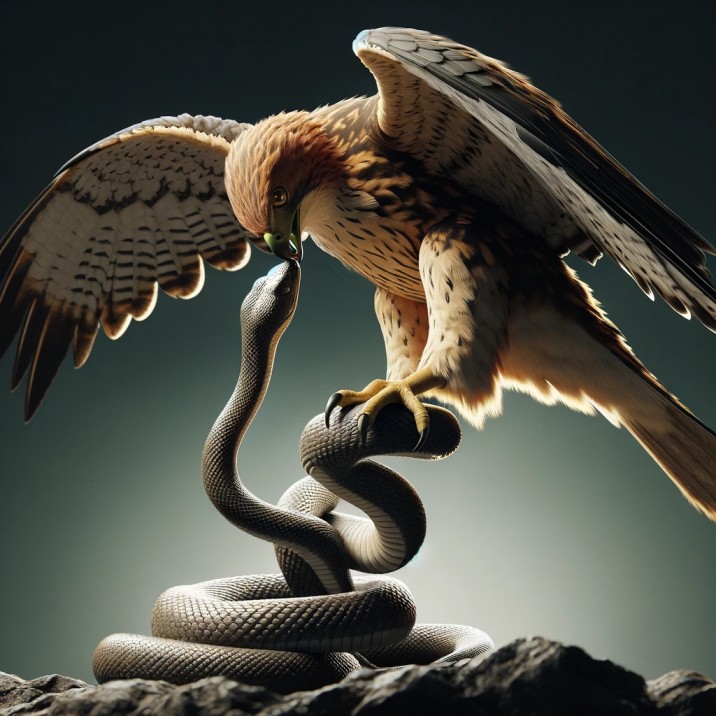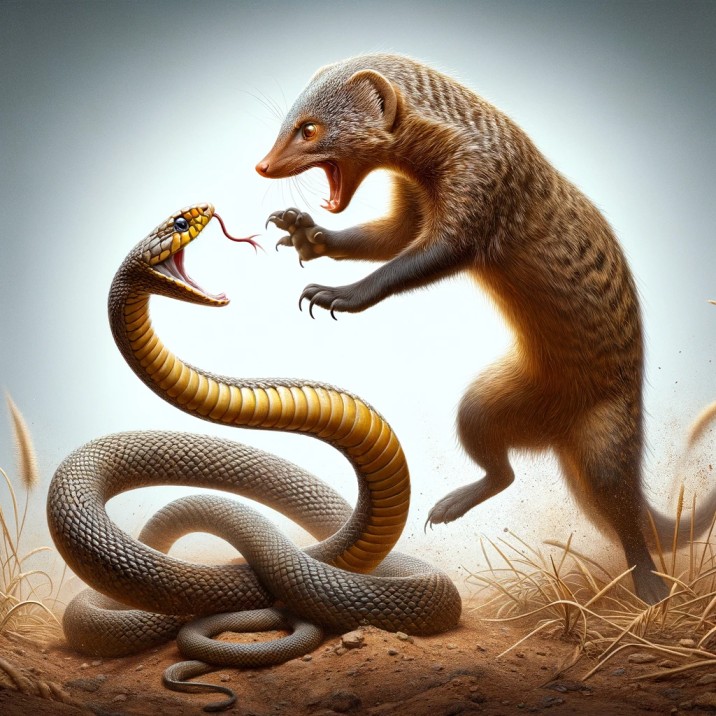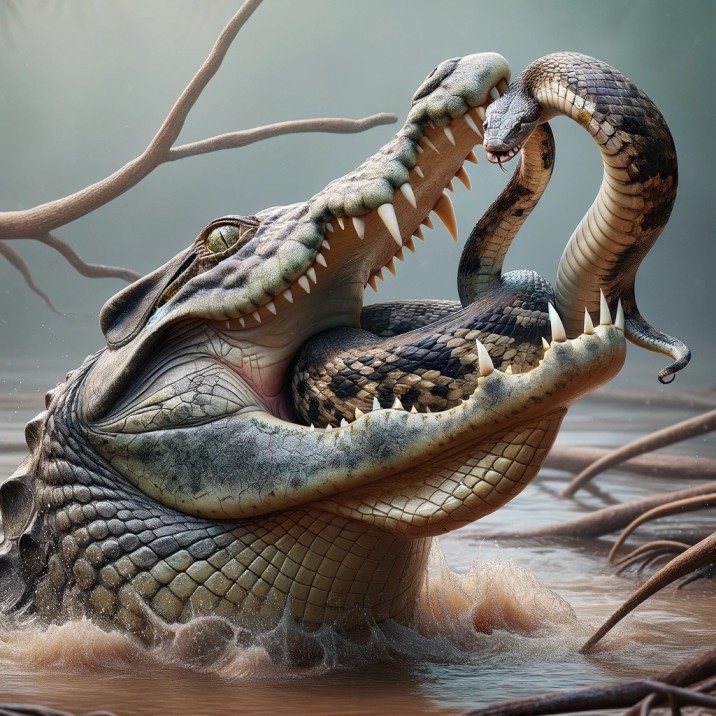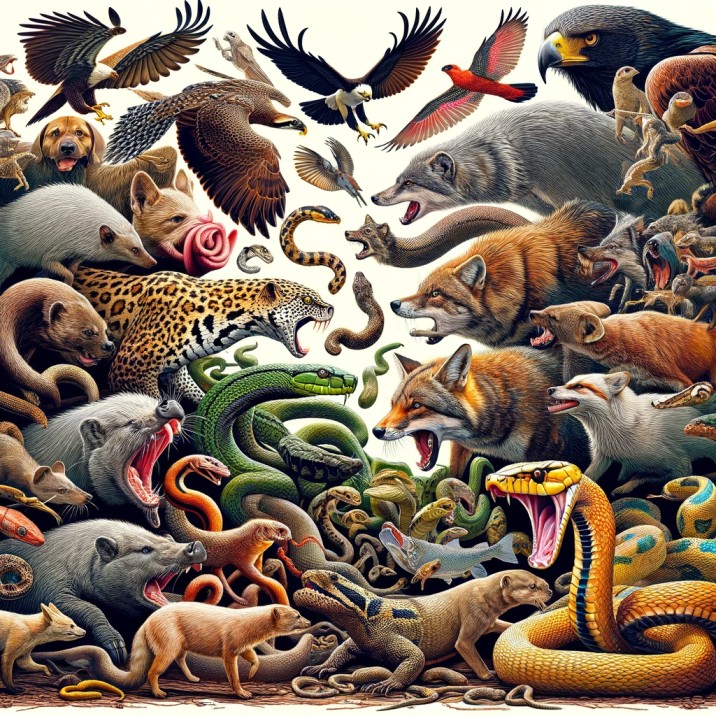Snakes, while being predators themselves, also fall prey to various other animals. Understanding the dynamics of these predator-prey relationships is essential for comprehending ecological balance. Here is a list of some common predators of snakes and an exploration of each of their roles in nature.
List of Snake Predators
- Birds of Prey (Hawks, Eagles, Owls)
- Mongoose
- Foxes
- Coyotes
- Wild Boars
- Other Snakes
- Humans
- Cats and Dogs (Domestic and Wild)
- Crocodiles and Alligators
- Large Fish (like Bass and Catfish)
Exploring Each Predator
Birds of Prey

Birds of prey, such as hawks, eagles, and owls, are top predators of snakes. Their keen eyesight allows them to spot snakes from great heights. Hawks and eagles often hunt during the day, while owls are nocturnal hunters. Their sharp talons and beaks are perfectly adapted to capture and kill snakes. The hunting techniques of these birds vary. Hawks and eagles, for instance, typically hunt during the day. They soar high in the sky, using their keen eyesight to spot snakes on the ground. Once a target is sighted, they dive at high speeds, catching the snake by surprise. Owls, being nocturnal hunters, rely on their silent flight and night vision to hunt snakes at night. Their ability to fly almost noiselessly gives them an edge in capturing unsuspecting nocturnal or crepuscular snakes.
Birds of prey are crucial in maintaining the balance of snake populations. By preying on snakes, they help control their numbers, preventing overpopulation and the associated ecological consequences. This predatory relationship also influences the behavior and distribution of snakes, as they evolve strategies to avoid these avian hunters.
Mongoose

Famously known for their snake-fighting abilities, mongooses are agile and quick, with reflexes that allow them to dodge snake strikes. They have a certain level of resistance to snake venom, which gives them an advantage in battles with venomous snakes. Their interactions are a classic example of natural predation dynamics. Mongooses are renowned for their agility and speed, which are crucial in their confrontations with snakes, including venomous species.
Mongooses have evolved certain physiological adaptations that give them a unique advantage. They possess a high level of acetylcholine receptors, making them resistant, though not immune, to snake venom. This resistance allows them to survive bites from venomous snakes, which is a remarkable feat in the animal kingdom.
Mongooses are known for their daring and intelligent hunting strategy. They provoke the snake to strike, deftly avoiding the attacks while looking for an opportunity to deliver a fatal bite to the back of the snake’s head. This method of hunting demonstrates their ability to outmaneuver and overpower snakes, which are otherwise dangerous adversaries.
Foxes

Foxes, known for their cunning nature, also prey on snakes. They use their keen sense of hearing to locate snakes and their agility to catch them. While not their primary food source, snakes form a part of their diverse diet. These cunning mammals exhibit a versatile hunting behavior that includes preying on snakes. Foxes, found in diverse habitats around the world, are omnivorous and adapt their diet to the available food sources, which sometimes include snakes.
Foxes use their keen sense of hearing to detect the movement of snakes, even those hidden in grass or underbrush. They are agile and quick, allowing them to pounce on and capture snakes effectively. Their hunting technique involves a combination of patience, stealth, and agility. Foxes will often stalk their prey silently and then leap to catch the snake off guard.
While snakes are not the primary component of a fox’s diet, they become significant in regions where these reptiles are abundant. Eating snakes helps control the population of these reptiles, contributing to the ecological balance in those areas.
Coyotes

Coyotes are opportunistic predators that feed on snakes when available. They hunt snakes by pouncing on them and killing them with a bite. Their adaptable diet helps them survive in various environments. Coyotes are known for their exceptional hunting skills. They primarily hunt by scent and sound, using their acute senses to locate snakes. Once they find a snake, they use their agility and speed to catch and kill it. Coyotes are cautious hunters, often assessing the risk before engaging with venomous snakes.
Wild Boars

In some regions, wild boars will prey on snakes. They use their strong tusks and snouts to dig out snakes from their burrows. However, snake hunting is more opportunistic rather than a primary food source for boars. Wild boars are adept foragers, using their strong snouts to root in the ground for food. This behavior often leads them to encounter snakes, particularly in habitats where snakes are prevalent. While not the primary predators of snakes, wild boars will prey on them when the opportunity arises. Their powerful jaws and sharp tusks enable them to effectively kill and consume snakes, including venomous species.
Other Snakes

Some snake species, like the King Cobra and the Kingsnake, are known to prey on other snakes. This cannibalistic behavior is part of the natural food chain and helps control snake populations. These snakes have evolved specialized diets and hunting techniques to capture and consume other snakes, including venomous ones. King Cobras, for instance, have an immunity to the venom of other snakes, making them formidable hunters of their own kind. This cannibalistic trait plays a significant role in controlling snake populations and maintaining ecological balance. It also highlights the diverse survival strategies within the reptilian world, where predator and prey can often be the same species. Understanding these intra-species interactions provides insights into the complexity of food webs and the evolutionary adaptations of these remarkable creatures.
Humans

Humans have a complex relationship with snakes, acting as one of their significant predators while also contributing to their conservation. Historically, humans have hunted snakes for various reasons, ranging from perceived threats, medicinal purposes, to using their skins for clothing and accessories. In some cultures, snakes are consumed as a food source. However, this predatory behavior has led to the decline in populations of certain snake species, contributing to ecological imbalances. On the flip side, increasing awareness of ecological conservation has led to efforts to protect snakes, recognizing their vital role in ecosystems. Humans’ impact on snake populations extends beyond direct predation to habitat destruction and environmental changes, which have further complicated this predator-prey dynamic. Understanding and mitigating these impacts is crucial for the conservation of snake species and the preservation of biodiversity.
Cats and Dogs

Cats and dogs, both domestic and wild, sometimes act as predators of snakes, although this is not a primary aspect of their behavior. Domestic cats may hunt smaller snakes out of instinct or curiosity. Their agile and stealthy nature makes them capable of catching and killing small reptiles, including snakes. Dogs, particularly larger breeds, may also chase and sometimes kill snakes, often as a defensive reaction to protect themselves or their human companions. In the wild, certain canine species like the African wild dog and larger feline species may prey on snakes as part of their varied diet. However, interactions with venomous snakes can be dangerous and sometimes fatal for cats and dogs. This predator-prey relationship is more opportunistic and incidental rather than a regular hunting behavior, reflecting the adaptability and varied diets of these animals.
Crocodiles and Alligators

Crocodiles and alligators, as apex predators in aquatic and semi-aquatic environments, occasionally prey on snakes. This predatory behavior is more common in regions where their habitats overlap with those of various snake species, including both terrestrial and aquatic types. Crocodiles and alligators are known for their opportunistic feeding habits, consuming a wide range of prey based on availability. Their diet typically includes fish, amphibians, other reptiles (including snakes), birds, and mammals. The inclusion of snakes in their diet reflects the adaptability and broad prey spectrum of these large reptiles.
Large Fish

Large fish, such as bass and catfish, are occasional predators of snakes, particularly in ecosystems where aquatic or semi-aquatic snakes are present. These fish species, known for their size and predatory nature, can play a role in controlling snake populations in freshwater environments. Bass and catfish, among other large fish, are opportunistic feeders. They primarily consume smaller fish, crustaceans, and insects, but they do not hesitate to prey on snakes that venture into or live in water. Their hunting strategy involves ambushing or swiftly attacking prey, utilizing their speed and size to capture snakes.
The natural predators of snakes play a crucial role in maintaining ecological balance. Each predator’s unique hunting technique and reason for preying on snakes reflect the complex interdependencies in nature. Understanding these relationships is key to appreciating the role of snakes in the ecosystem and the importance of conserving both the predators and their prey.

